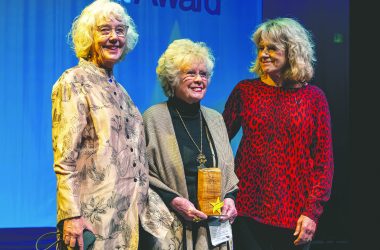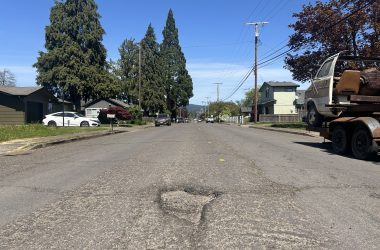 THE OCTOBER 1957 ISSUE OF AMAZING STORIES MAGAZINE, PUBLISHED 10 YEARS AFTER NOLAN SKIFF AND BILL BEQUETTE STARTED THE FAD WITH THEIR ARTICLE ABOUT KENNETH ARNOLD’S UFO SIGHTING IN THE PENDLETON EAST OREGONIAN, WAS ”THE FLYING SAUCER ISSUE.” Image provided/Ziff-Davis Publishing Co.
THE OCTOBER 1957 ISSUE OF AMAZING STORIES MAGAZINE, PUBLISHED 10 YEARS AFTER NOLAN SKIFF AND BILL BEQUETTE STARTED THE FAD WITH THEIR ARTICLE ABOUT KENNETH ARNOLD’S UFO SIGHTING IN THE PENDLETON EAST OREGONIAN, WAS ”THE FLYING SAUCER ISSUE.” Image provided/Ziff-Davis Publishing Co.
If you were getting ready to take a UFO-themed road trip around the western U.S., there are several places that would naturally be at the top of the list.
There’s Roswell, New Mexico, of course. And Area 51 in Nevada. And while in Nevada, a trip to the town of Pahrump – from which, since 1984, the great Art Bell and later George Noory have filled the small hours after every midnight with the four-hour Coast to Coast AM paranormal talk show.
Most casual UFO aficionados wouldn’t put any Oregon destinations on that list unless they happened to be taking their tour in the third weekend of May, in which case a visit to the McMinnville UFO Festival might be on the itinerary. (But, they might not actually know why McMinnville has a UFO festival. Plenty of people don’t.)
But, although Oregon is neither the Mecca nor the Medina of UFOlogy, the state’s role in the history of UFO sightings is more significant than most people think. For one thing, the term ”flying saucer” probably originated in Pendleton.
Here’s how that happened:
On June 24, 1947, Kenneth Arnold, owner of Great Western Fire Control Supply in Boise, was flying home from a meeting in Washington in his private plane when he decided to take a little detour. A Marine Corps transport plane had disappeared near Mount Rainier, having apparently crashed there; and relatives of the victims of the crash had offered a $5,000 reward for anyone who could find the crash site so that they could retrieve their loved ones’ remains. Arnold figured an extra hour or two would be well invested if there was a shot at five grand.
Arnold didn’t find the plane. But, he did find something else:
”He said he sighted nine saucer-like air craft flying in formation at 3 p.m. yesterday, extremely bright – as if they were nickel-plated – and flying at an immense rate of speed,” wrote reporters Nolan Skiff and Bill Bequette of the Pendleton East Oregonian, in a story on the front page of the next day’s edition. ”He estimated they were at an altitude between 9,500 and 10,000 feet and clocked them from Mount Rainier to Mount Adams, arriving at the amazing speed of about 1,200 miles an hour. ‘It seemed impossible,’ he said, ‘but there it is – I must believe my eyes.’”
Arnold’s first thought – remember, this was 1947 – was that the strange objects might be guided missiles or remote-controlled spy craft from the Soviet Union. So, upon landing at Pendleton, his first stop was the local FBI office. Finding that closed, he headed for the offices of the East Oregonian and spilled his story to Bequette and Skiff.
Bequette and Skiff were on deadline, and had just five or 10 minutes in which to talk to Arnold and pound out a story for the next day’s paper. So, although Arnold told them the mysterious craft were shaped with a crescent-shaped leading edge and a triangular tail trailing out behind, they missed that part in their story, picking up instead on his description of the strange objects flying ”like a saucer would if you skipped it across the water” and went with that.
And thus was born the legend of the Flying Saucer.
(There is some dispute over whether this was in fact the first time ”flying saucer” was used in reference to UFOs. But what is unquestionably true is that it was this story, picked up on the Associated Press wire and run all over the country, that injected the term into widespread pop-culture use.)
A number of other sightings of similar objects, from the same area, were reported shortly after the story broke. It’s certainly possible that the UFOs might have been some sort of top-secret project being test-flown out of Fairchild Air Force Base in Spokane. But if so, the Air Force has never seen fit to confirm or clarify.
Oregon’s strongest other connection to UFOlogy is the incident that inspired the annual McMinnville UFO Festival: a sighting, and photographing, of something that looks disturbingly like a genuine flying saucer.
McMinnville’s UFO roots are deeper than most people realize. Just before Thanksgiving in 1896, at the start of the ”California airship” outbreak of UFO sightings, several McMinnville lads provided the first UFO sighting in Oregon history (to the best of my current knowledge).
”Tuesday night several of the boys about town saw the Sacramento air ship sail over this city, at least they saw lights in the heavens,” the McMinnville Telephone-Register reported in the Nov. 24 edition. ”This they swear to.”
But the more well-known McMinnville UFO sighting, and the one that inspired the festival, happened on May 11, 1950, when local farmer Evelyn Trent went out in the evening to feed the chickens and rabbits their evening meal. When she did, she couldn’t help but notice that there was a large metallic disc-shaped object hovering silently in the sky to the northeast.
She ran back to the house, yelling for her husband Paul to get his camera – an old-school Universal Roamer handheld bellows model shooting 60-mm roll film (probably Kodak 120). Paul rummaged around for a bit trying to track the camera down, but came up with it just in time, and the two of them raced back outside in time to catch one image of the strange craft hovering over their farm, and another of it whisking away to the northwest, where it disappeared over the horizon.
Those two photographs would, for a few months afterward, put McMinnville on the map nationwide and set records for press runs in the McMinnville Telephone-Register that would stand for decades. They would also turn out to be extraordinarily resistant to falsification – in other words, either they were the real thing, or they were the product of a phenomenally clever (or lucky) hoaxer.
(Sources: Bartholomew, Robert E. ”From Airships to Flying Saucers: Oregon’s Place in the Evolution of UFO Lore,” Oregon Historical Quarterly, v.101 n.2 (summer 2000); ufofest.com/festival-info/history)
Finn J.D. John teaches at Oregon State University and writes about odd tidbits of Oregon history. For details, see http://finnjohn.com. To contact him or suggest a topic: [email protected] or 541-357-2222.








